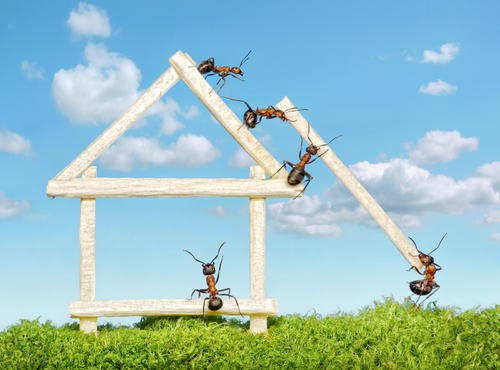 We recently moved into a gorgeous 112-year-old house in the historic district of our town. We are renting long-term with an option to buy. We have an awesome landlord who has let us really make this our home and he’s very easy to work with. He and his wife had contracted the local affiliate of a national pest control service. They have offered us the benefit for free, which is generous. However, I’ve owned several old houses and I’ve never used chemical pest control methods.
We recently moved into a gorgeous 112-year-old house in the historic district of our town. We are renting long-term with an option to buy. We have an awesome landlord who has let us really make this our home and he’s very easy to work with. He and his wife had contracted the local affiliate of a national pest control service. They have offered us the benefit for free, which is generous. However, I’ve owned several old houses and I’ve never used chemical pest control methods.
I’m not particularly good with insects, but I know they are a vital part of our eco-system. I have spent a lot of time and energy over the years working on making peace with the insect world and finding ways to co-exist. Don’t get me wrong, I REALLY don’t like ants in my kitchen, spiders in the bedroom or other various multi-legged critters terrorizing us inside the house. When I find a misguided critter in the house, I do my best NOT to freak out and put them back outside with a stern lecture on staying OUTSIDE.
I’m the one with the scrappy lawn because I refuse to use chemical fertilizers on it. I’m sensitive to chemicals and just know too much about the negative effects of many chemicals not only on our bodies, but in our environment as well. There are many studies showing how our bodies are being overburdened by toxins and how babies are now being born pre-polluted – yikes! Environmental Working Group has done a lot of homework for us and offers tons of resources for research on commonly used chemicals, toxins and their effects on our health and their environmental impact.
 So, one morning the nice pest control man knocks on the door unexpectedly. I’m sure he figured he’d just let me know he would be spraying the outside of the house and he didn’t expect me to start questioning him about the type of chemicals they use and what exactly they are for – killing v. deterring. I asked if he had any non-toxic pest control methods and he started at me blankly, so I said, “Thanks, but let me do some research and I’ll get back to you.” He looked genuinely baffled, but he eventually gave up and wandered back to his truck.
So, one morning the nice pest control man knocks on the door unexpectedly. I’m sure he figured he’d just let me know he would be spraying the outside of the house and he didn’t expect me to start questioning him about the type of chemicals they use and what exactly they are for – killing v. deterring. I asked if he had any non-toxic pest control methods and he started at me blankly, so I said, “Thanks, but let me do some research and I’ll get back to you.” He looked genuinely baffled, but he eventually gave up and wandered back to his truck.
I had my intern do some research and the pest control company stonewalled her. I gave it a try, and they weren’t any better with me. Their website doesn’t divulge ANY information about the types of chemicals they use. OK – one can only surmise, whatever they use must be toxic or they wouldn’t work so hard to keep the information from you! Luckily for me, my landlord is interested in helping the environment and was ok with my doing some homework and considering some possible alternatives.
It is important to realize that in an environment where humans and man-made structures do not exist, insects play a vital role in the eco-system. We consider insects pests when they appear to be invading our space. Termites for instance can do severe damage to a wood dwelling, but in nature, their role is key to help the decomposition process of dead trees. While I don’t think I’ve got arachnophobia, I’m not happy when I see spiders in the house. They are icky, but generally harmless to humans. I LOVE that they eat other insects, so they are among those that are carefully escorted outside with the standard lecture to keep it outside.
Here are some natural and non-toxic alternatives
to keep household pests at bay
 For garden variety creepy crawlers: ants, aphids, bed bugs, carpet beetles, cockroaches, ear wigs, fleas, flies (fruit & house), silverfish, spiders, ticks, etc. – ahhhhhhhh!
For garden variety creepy crawlers: ants, aphids, bed bugs, carpet beetles, cockroaches, ear wigs, fleas, flies (fruit & house), silverfish, spiders, ticks, etc. – ahhhhhhhh!
I try to encourage bugs to live outside the house, but if they are persistent about being inside, I would definitely consider this treatment:
Food-grade Diatomaceous Earth: a chalky powder that is the natural fossilized remains of diatoms (a type of hard-shelled algae). The diatom particles are small and sharp, but at their microscopic size they are only harmful to the exoskeletons of small insects. It is a mechanical killer, not a chemical one. Food-grade diatomaceous earth is so safe you can sprinkle it throughout your house, around your vegetable patch, and even rub it into a pet’s fur. Keep in mind that this product may also kill beneficial critters. To use, sprinkle a thin layer indoors or outdoors where insects are found. Leave for two days or however long you need to control the bugs and then clean up and reapply as needed. Also called ‘Insect Dust,’ this product is a registered insecticide with the government.
A 4.4 lb. bag of Insect Dust (Diatomaceous Earth) from St. Gabriel Organics costs $9.99
Cucumber: place a few peels of cucumber at the entry point of invasion of the pest to repel/deter. Works for ants, cockroaches, and silverfish.
Mint leaves: scatter these in places of infestation to deter ants and flies.
Eucalyptus oil: drop some on cloth and place near areas of infestation of flies and moths.
Soapy water: If you want to instantly kill an insect in your home – Mix water and soap flakes (from something like a bar of Ivory soap) into a spray bottle, you can kill all bugs on contact. This is because the soap component breaks down the waxy exoskeleton and lets the water enter the bug and drown the critters quickly. Sorry bug!
For termites

 Sand barriers: sand barriers are a preventative measure that works on an underground termite invasion because those termites cannot tunnel through sand at certain grain-sizes, and sand does not retain moisture, which is crucial to termite colonization. Sand barriers can be applied in crawl spaces under pier and beam foundations, under slab foundations, and between the foundation and concrete porches, terraces, patios and steps. Other possible locations include under fence posts, underground electrical cables, water and gas lines, telephone and electrical poles, inside hollow tile cells and against retaining walls. You need sixteen-grit sized sand and the layer must be at least 4 inches thick in between wood structures and soil. This is a physical method of control rather than chemical and provides long-term protection, but should still be regularly inspected.
Sand barriers: sand barriers are a preventative measure that works on an underground termite invasion because those termites cannot tunnel through sand at certain grain-sizes, and sand does not retain moisture, which is crucial to termite colonization. Sand barriers can be applied in crawl spaces under pier and beam foundations, under slab foundations, and between the foundation and concrete porches, terraces, patios and steps. Other possible locations include under fence posts, underground electrical cables, water and gas lines, telephone and electrical poles, inside hollow tile cells and against retaining walls. You need sixteen-grit sized sand and the layer must be at least 4 inches thick in between wood structures and soil. This is a physical method of control rather than chemical and provides long-term protection, but should still be regularly inspected.
Nematodes: these microscopic worms are a good form of termite treatment for chemically-sensitive individuals and environmentally-sensitive areas. Nematodes can be pumped into the infested area and they will kill the termites. Ick.
Cedar oil: products such as CedarCide’s Agent Gold contain cedar oil, which is apparently very lethal to termites but totally non-toxic, organic, and chemical-free. It is a very effective contact killer and repellent to termites and can be used on any wood structure. The way it works is that the product penetrates the wood and the aromas from the cedar oil disrupt termite (and apparently ants – bonus!) pheromone systems in a lethal manner. The cedar oil also a drying agent and promotes moisture evacuation from the wood, which also helps prevent and eliminate the existence of termites.
Other non-toxic methods: electric shock treatments (really!?), microwave devices (Oh my!), physical termite trapping/nest excavation.
Almost Non-Toxic – Boric acid bait blocks: if you place these around the structure where you need to eliminate termites, these blocks will attract the pests (termites) to consume termiticides and die without broad chemical application. This is a less-toxic alternative to widespread pesticide spraying to your home. Also works on roaches.
Carpenter Ants
 Temperature control: freezing or heating methods (such as with a tent) will kill ant colonies since they are very sensitive to temperature ranges in the wood ‘galleries’ that they form in structures. There are pest control companies that do this.
Temperature control: freezing or heating methods (such as with a tent) will kill ant colonies since they are very sensitive to temperature ranges in the wood ‘galleries’ that they form in structures. There are pest control companies that do this.
Diatomaceous Earth: same as above . . . kills carpenter ants in the same way. Make sure to only get FOOD GRADE DE as other forms of DE are dangerous and not necessarily harmless to plants, animals, and people.
Prevention: Fix/replace any dry rot wood in your home or wood damaged by moisture. That is a breeding ground for carpenter ants.
resources include:
Earth Easy – Natural Pest Control
Electroherbalism – Toxic Avoidance Pest Control
image of ants via shutterstock
image of termite via shutterstock


One Comment